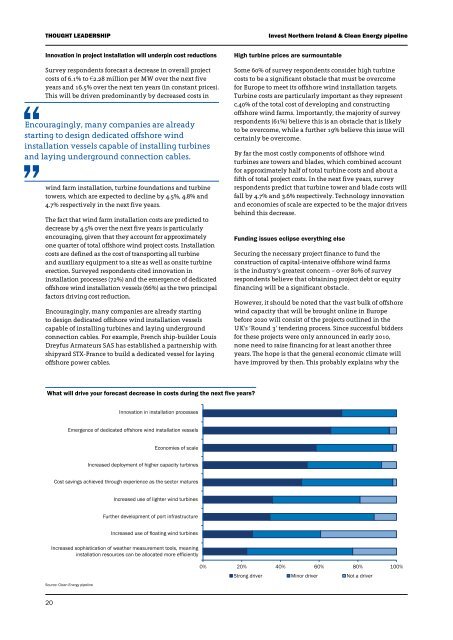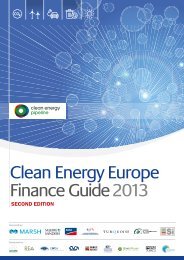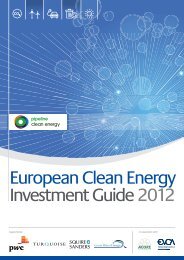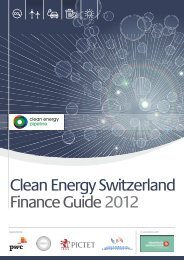European Clean Energy Investment Guide 2012
European Clean Energy Investment Guide 2012
European Clean Energy Investment Guide 2012
Create successful ePaper yourself
Turn your PDF publications into a flip-book with our unique Google optimized e-Paper software.
ThoughT leadership invest Northern ireland & <strong>Clean</strong> energy pipeline<br />
Innovation in project installation will underpin cost reductions<br />
Survey respondents forecast a decrease in overall project<br />
costs of 6.1% to €2.28 million per MW over the next five<br />
years and 16.5% over the next ten years (in constant prices).<br />
This will be driven predominantly by decreased costs in<br />
“ Encouragingly, many companies are already<br />
starting to design dedicated offshore wind<br />
installation vessels capable of installing turbines<br />
and laying underground connection cables.<br />
”<br />
wind farm installation, turbine foundations and turbine<br />
towers, which are expected to decline by 4.5%, 4.8% and<br />
4.7% respectively in the next five years.<br />
The fact that wind farm installation costs are predicted to<br />
decrease by 4.5% over the next five years is particularly<br />
encouraging, given that they account for approximately<br />
one quarter of total offshore wind project costs. Installation<br />
costs are defined as the cost of transporting all turbine<br />
and auxiliary equipment to a site as well as onsite turbine<br />
erection. Surveyed respondents cited innovation in<br />
installation processes (72%) and the emergence of dedicated<br />
offshore wind installation vessels (66%) as the two principal<br />
factors driving cost reduction.<br />
Encouragingly, many companies are already starting<br />
to design dedicated offshore wind installation vessels<br />
capable of installing turbines and laying underground<br />
connection cables. For example, French ship-builder Louis<br />
Dreyfus Armateurs SAS has established a partnership with<br />
shipyard STX-France to build a dedicated vessel for laying<br />
offshore power cables.<br />
What will drive your forecast decrease in costs during the next five years?<br />
Increasing Increased sophistication sophistication of of weather weather measurement measurement tools, tools, meaning meaning<br />
installation installation resources resources can be can allocated be allocated more efficiently more efficiently<br />
20<br />
Innovation in installation processes<br />
Emergence of dedicated offshore wind installation vessels<br />
Economies Economies of of scale scale<br />
Increasing Increased deployment of higher higher capacity turbines turbines<br />
Cost Natural savings cost achieved savings through experience as the sector matures<br />
Increasing use of lighter<br />
Increased<br />
wind<br />
use<br />
turbines<br />
of lighter<br />
easing<br />
wind<br />
installation<br />
turbines<br />
processes<br />
Further development of port infrastructure<br />
Increasing use of floating Increased wind use turbines of floating easing wind installation turbines<br />
processes<br />
Source: <strong>Clean</strong> <strong>Energy</strong> pipeline<br />
High turbine prices are surmountable<br />
Some 60% of survey respondents consider high turbine<br />
costs to be a significant obstacle that must be overcome<br />
for Europe to meet its offshore wind installation targets.<br />
Turbine costs are particularly important as they represent<br />
c.40% of the total cost of developing and constructing<br />
offshore wind farms. Importantly, the majority of survey<br />
respondents (61%) believe this is an obstacle that is likely<br />
to be overcome, while a further 19% believe this issue will<br />
certainly be overcome.<br />
By far the most costly components of offshore wind<br />
turbines are towers and blades, which combined account<br />
for approximately half of total turbine costs and about a<br />
fifth of total project costs. In the next five years, survey<br />
respondents predict that turbine tower and blade costs will<br />
fall by 4.7% and 3.6% respectively. Technology innovation<br />
and economies of scale are expected to be the major drivers<br />
behind this decrease.<br />
Funding issues eclipse everything else<br />
Securing the necessary project finance to fund the<br />
construction of capital-intensive offshore wind farms<br />
is the industry’s greatest concern – over 80% of survey<br />
respondents believe that obtaining project debt or equity<br />
financing will be a significant obstacle.<br />
However, it should be noted that the vast bulk of offshore<br />
wind capacity that will be brought online in Europe<br />
before 2020 will consist of the projects outlined in the<br />
UK’s ‘Round 3’ tendering process. Since successful bidders<br />
for these projects were only announced in early 2010,<br />
none need to raise financing for at least another three<br />
years. The hope is that the general economic climate will<br />
have improved by then. This probably explains why the<br />
0% 20% 40% 60% 80% 100%<br />
Strong driver Minor driver Not a driver





